The Heartbeat of American Culture
Swing style emerged in the United States during the late 1920s, characterized by its distinctive rhythmic feel, big band arrangements, and partner dancing. This cultural movement dominated American entertainment from approximately 1935 to 1946, known as the “swing era.”
What is Swing Style?
* Music: Jazz style featuring accented off-beats, lilting eighth notes, syncopation, and walking bass lines
* Dance: Partner dances like Lindy Hop, Balboa, and Charleston with improvisational elements
* Culture: A social movement that crossed racial barriers during the Harlem Renaissance
* Era: Peaked between 1935-1946, with revivals in the 1980s and 1990s
Swing music originated in African American communities, gaining national popularity through bandleaders like Duke Ellington, Count Basie, and Benny Goodman. The style’s name comes from its distinctive rhythmic “swing” that emphasizes beats 2 and 4.
The accompanying dances evolved alongside the music, with the Lindy Hop (invented in 1927 in Harlem) becoming the most iconic. Other styles include Charleston, Balboa, East Coast Swing, and West Coast Swing.
As Louis Armstrong said about swing: “If you don’t feel it, you’ll never know it.”
I’m Leslie Tuttle, and I’ve spent years exploring the vibrant connections within swing communities, helping enthusiasts find like-minded partners who share their passion for swing style and social dancing.
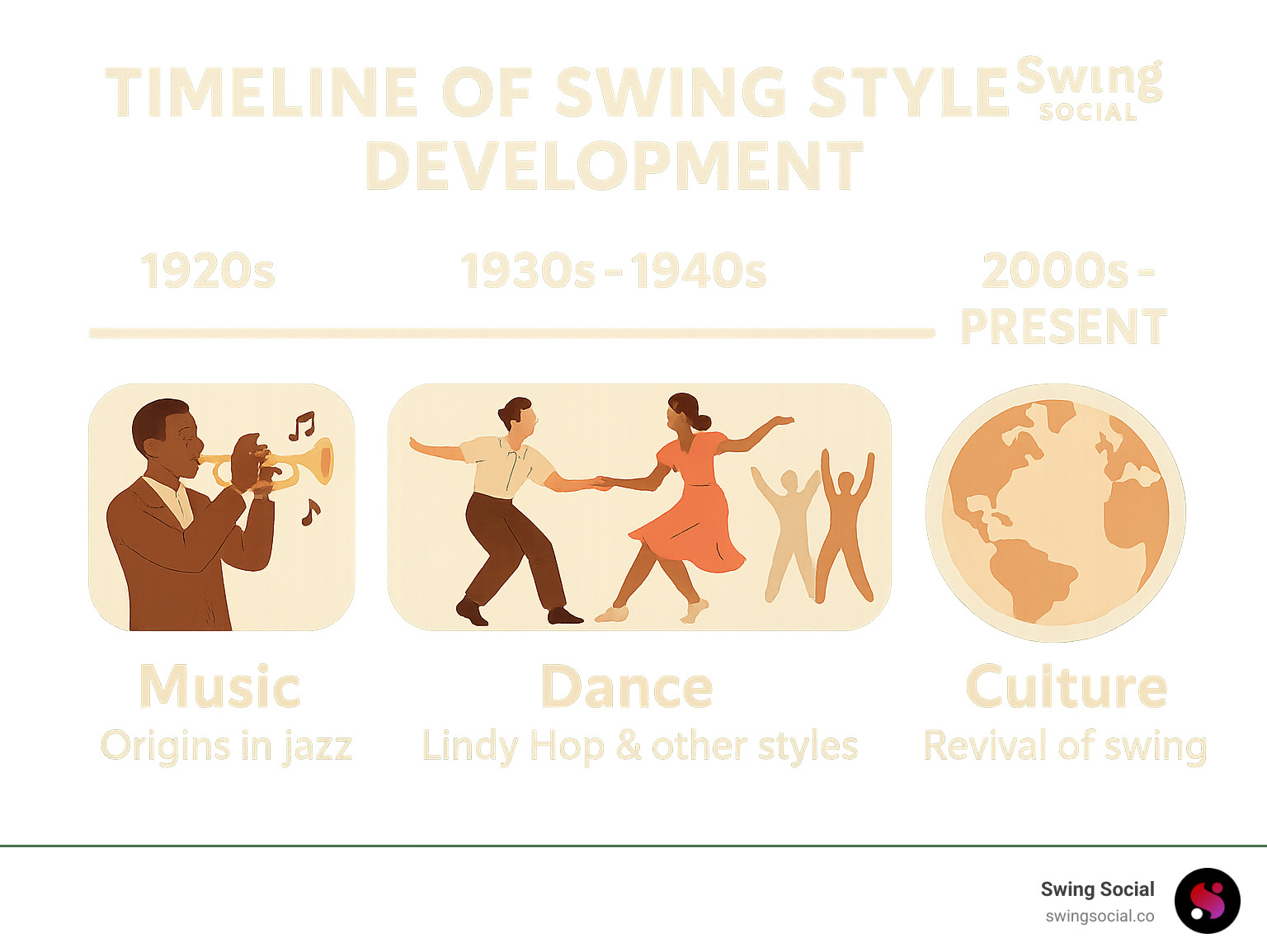
Swing style vocab explained:
– swinger styles
– swinger style stories
Defining Swing Style
What exactly makes music or dance “swing”? At its heart, swing style isn’t just a technique—it’s a feeling, a conversation, a way of moving through the world. When you hear true swing, your foot starts tapping before your brain even registers why.
The Essence of Swing Style in Music
The secret sauce of swing style starts with those accented off-beats—unlike classical music’s emphasis on beats 1 and 3, swing puts the spotlight on beats 2 and 4, creating forward momentum. Then there’s the distinctive swing eighths—that “long-short” pattern that gives the music its lilting quality. A solid walking bass provides the heartbeat, while brass riffs punctuate with call-and-response patterns that echo African musical traditions.
“It don’t mean a thing if it ain’t got that swing,” Duke Ellington famously wrote. That indefinable rhythmic lilt—part mathematics, part soul—transforms ordinary notes into something that makes your body want to move.
The Essence of Swing Style on the Dance Floor
On the dance floor is where swing style truly comes to life through human connection. Partner connection forms the foundation—unlike today’s individualistic dance styles, swing dancing is fundamentally social. The iconic swing-out embodies this perfectly—partners move away from each other while maintaining connection, then return, mirroring the music’s own tension and release.
What makes swing dancing special is its blend of structure and freedom. Yes, there are patterns to learn, but the joy comes in playing with those patterns, improvising responses to your partner and the music. In more advanced dancing, especially in Lindy Hop, this playfulness might include aerials—those crowd-pleasing moments where dancers briefly defy gravity.
“It ain’t what you do, it’s the way that you do it!” captures the spirit perfectly. Two dancers might do identical steps, but one pair will have that special something—that swing style—that makes you unable to look away.
The Evolution of Swing Style: From Roots to Revival
The story of swing style grew organically from the rich soil of early jazz, blossoming when the conditions were just right.
In the early 1900s, the streets of New Orleans hummed with a new kind of music—jazz that featured musicians improvising together with an infectious rhythm. As African American musicians traveled north during the Great Migration, they carried these musical seeds to Chicago, Kansas City, and New York.
The 1920s saw bandleader Fletcher Henderson organizing musicians into sections of brass and reeds, backed by a steady rhythm section. When his arranger Don Redman began writing parts where these sections would call back and forth to each other, the conversation that defines swing style truly began.
Meanwhile, Duke Ellington was holding court at Harlem’s Cotton Club, refining this new sound with his sophisticated compositions. Down in Kansas City, Count Basie was developing his own approach—more relaxed, deeply rooted in the blues.
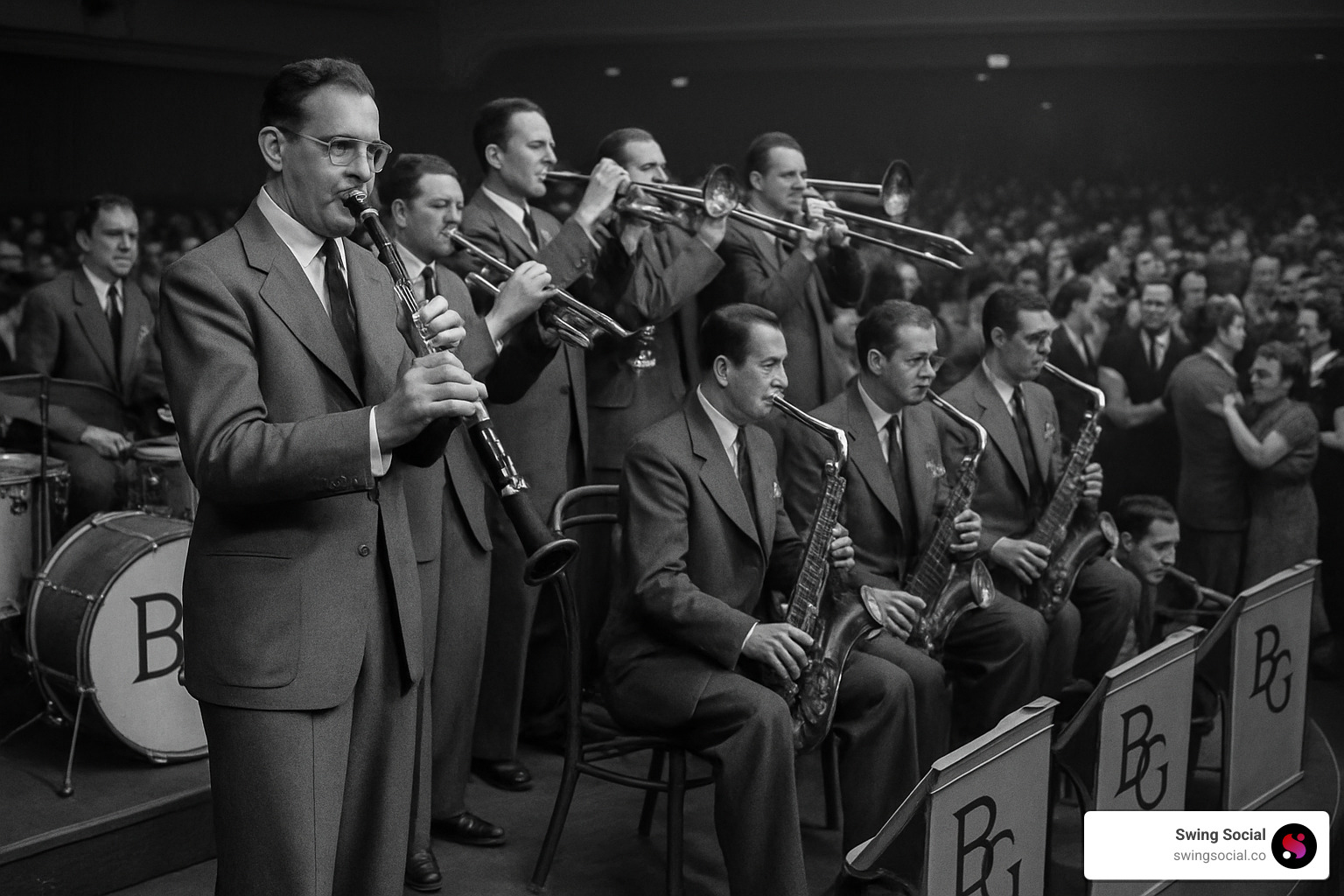
Milestone Moments
The night of August 21, 1935 changed everything. Benny Goodman’s band took the stage at the Palomar Ballroom in Los Angeles. When they played their hottest arrangements, the young crowd went wild. That night, the national swing craze was born.
The legendary Savoy Ballroom in Harlem became the testing ground for swing style innovation through their famous “battles of the bands.” These friendly competitions pushed musicians to new heights of creativity and technical skill.
World War II dealt a blow—many musicians were drafted, gas rationing made touring nearly impossible, and smaller combos became more practical than big bands. After the war, new musical forms emerged—bebop, rhythm and blues, and eventually rock and roll. Big bands became harder to sustain financially.
But the heart of swing style never stopped beating. In the 1980s, dancers in New York, California, and Sweden began refinding Lindy Hop. The 1990s brought a full-blown revival, with bands like Royal Crown Revue and Big Bad Voodoo Daddy introducing swing to a new generation.
Today, swing style continues to evolve. Electro swing blends traditional swing elements with electronic dance music. Scientific research on African American swing pioneers continues to deepen our understanding of this important cultural contribution.
Anatomy of the Swing Sound & Step
Ever wonder what makes your toes tap the moment a swing tune starts playing? That unmistakable swing feeling comes from a special recipe of rhythm, instrumentation, and movement.
Instruments That Drive the Groove
The heart of any swing band is its rhythm section. The drummer’s ride cymbal creates that signature “ding-ding-a-ding” pattern that defines the swing rhythm, while the hi-hat pops on beats 2 and 4, giving the music forward momentum.
The upright bass replaced the tuba from earlier jazz, bringing newfound agility. Bass players typically walk through chord changes with four notes per bar, creating both harmonic foundation and rhythmic drive.
Piano and guitar fill out the rhythm section, with pianists often splitting duties between their hands. Up front, the horn sections bring personality and power. Brass instruments deliver punchy riffs and soaring solos, while the reed section adds warmth and complexity.
As Count Basie showed us, sometimes the most powerful moments in swing style come from what you don’t play. His minimalist approach left breathing room for the rhythm section.
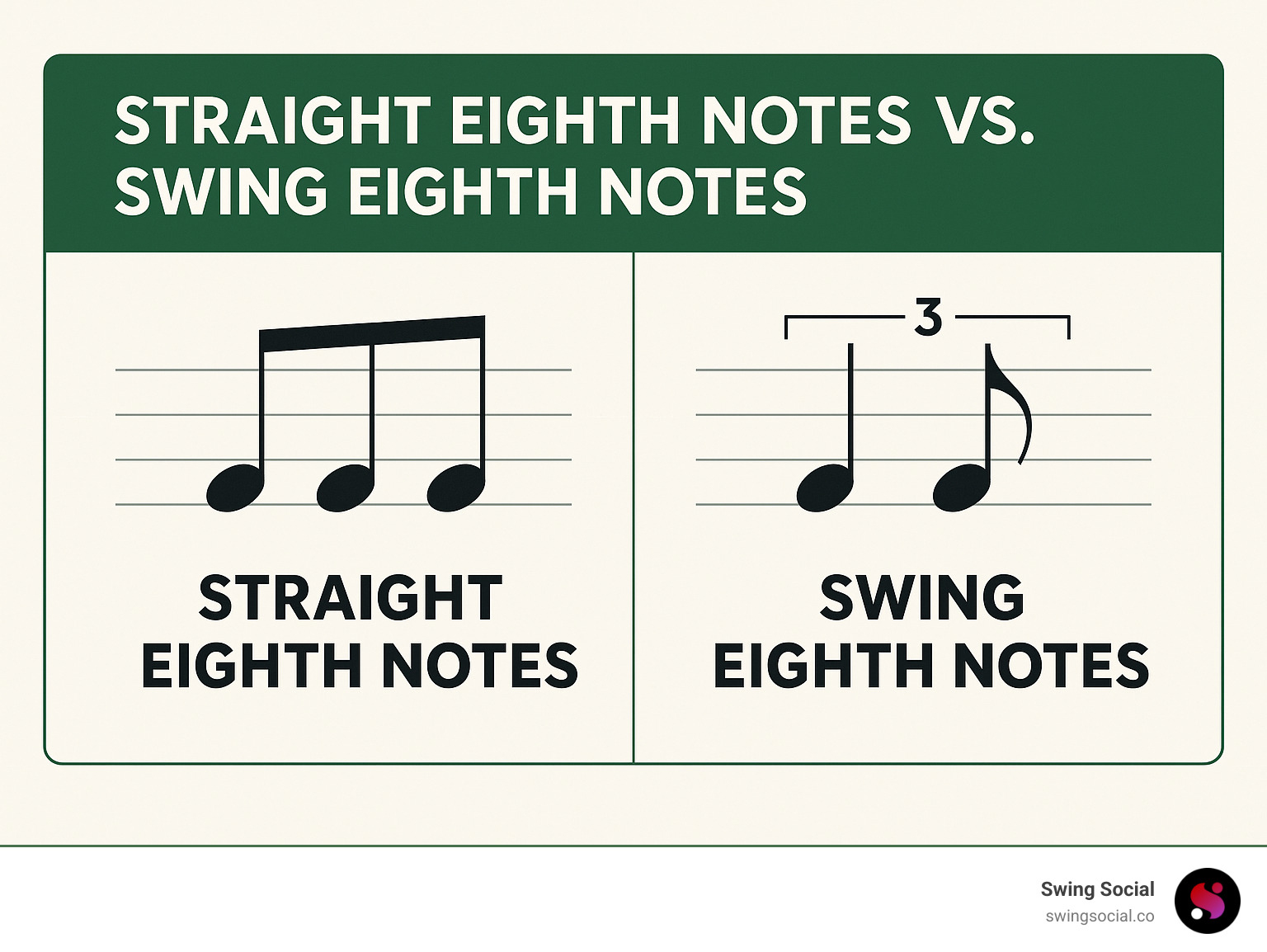
Iconic Swing Standards
Certain tunes have become the soundtrack of swing style. “Moten Swing,” developed by Bennie Moten’s Kansas City Orchestra (featuring a young Count Basie), established that relaxed, bluesy Kansas City approach.
When Benny Goodman’s band launched into “Sing, Sing, Sing,” with Gene Krupa’s thundering tom-toms, audiences went wild. This driving composition became the showstopper at Goodman’s groundbreaking 1938 Carnegie Hall concert.
Duke Ellington’s signature “Take the ‘A’ Train,” composed by Billy Strayhorn, showcases sophisticated arranging that exemplifies the more refined side of swing style. Meanwhile, Glenn Miller’s “In the Mood” hooks listeners with its catchy riff passed between sections of the band.
These classics are still spun by DJs at swing dances worldwide. Each tune has its own personality that dancers respond to differently—some inspire playful, energetic movement, while others evoke smoother, more subtle styling.
Swing on the Dance Floor: Styles & Techniques
When swing style music plays, magic happens on the dance floor. This family of dances evolved alongside the music, each with its own personality and story.
Choosing Your Swing Style
Wondering which swing dance might be your perfect match? If you’re drawn to faster tempos, Lindy Hop, Charleston, or Collegiate Shag might be calling your name. For those who prefer middle-of-the-road tempos, East Coast Swing offers accessible patterns that work beautifully with medium-speed songs.
If you prefer something more grounded or enjoy slower music, Balboa or West Coast Swing could be your style. Balboa was born on crowded dance floors where dancers needed to conserve space, developing intricate footwork while maintaining close connection. Meanwhile, West Coast Swing offers a smooth, elastic quality that feels almost conversational between partners.
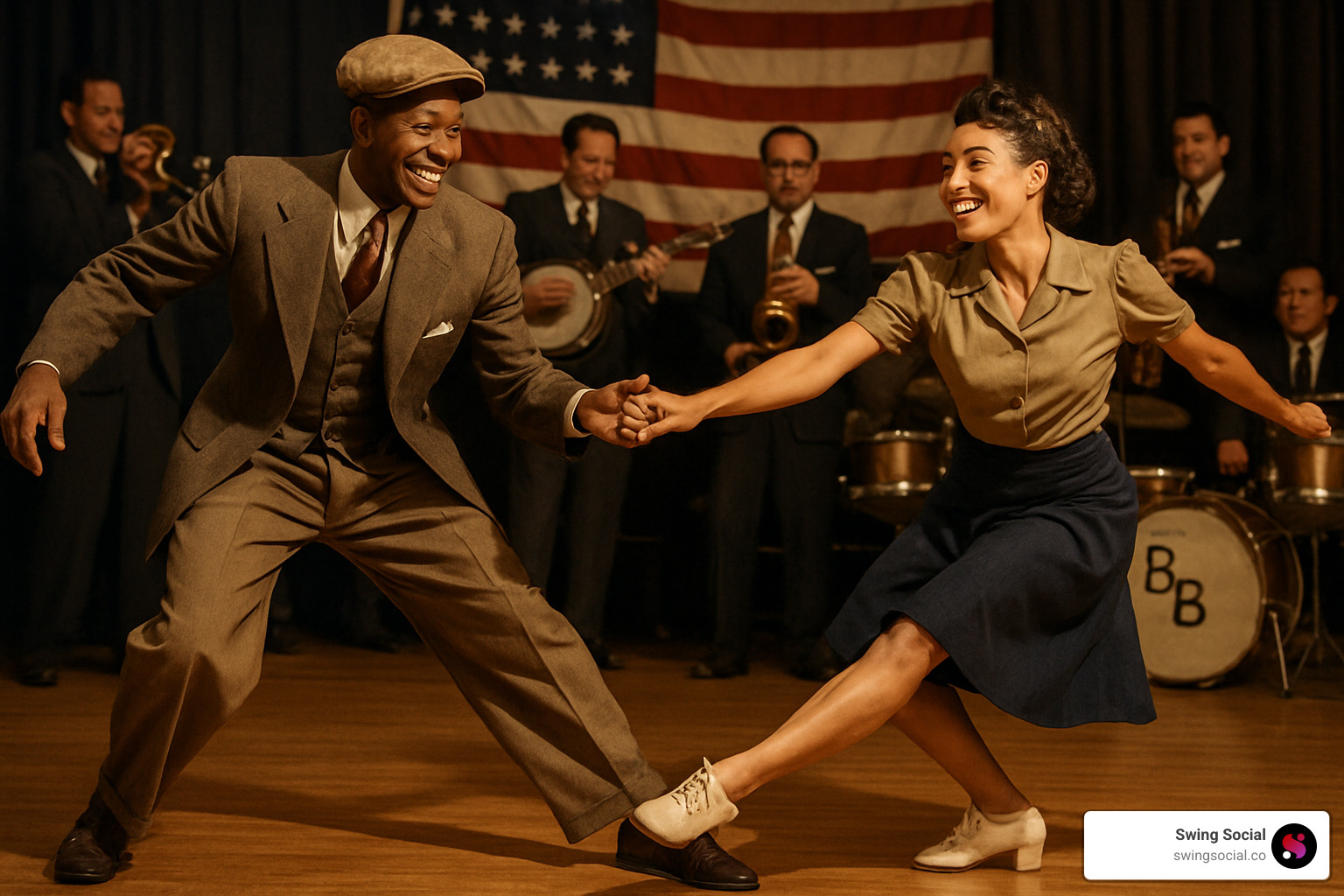
Lindy Hop stands as the original swing dance, born in Harlem’s ballrooms in the late 1920s. It features both 6-count and 8-count patterns with that signature “swing-out” where partners move apart while maintaining connection, then come back together.
Charleston began as the rebellious solo dance of the Roaring Twenties before being folded into the Lindy Hop vocabulary. Collegiate Shag brings a bouncy, energetic quality with its double-pulse hop on each beat.
East Coast Swing emerged when Arthur Murray studios simplified Lindy Hop in the 1940s, creating an accessible 6-count pattern with circular movements. It’s often the first swing dance taught to beginners.
West Coast Swing evolved from Lindy in the post-war years, developing a distinctive slotted pattern where partners dance along a line rather than in a circular pattern.
Learning the Basics
No matter which swing style catches your eye, you’ll encounter some fundamental concepts:
The foundation starts with rhythm and timing – understanding those basic 6-count or 8-count patterns. From there, you’ll find the importance of connection – that magical communication between partners through physical contact and body positioning.
Proper frame creates the structure that allows partners to clearly communicate direction and energy. Meanwhile, mastering basic footwork patterns like the triple step gives you the vocabulary to express the music through movement.
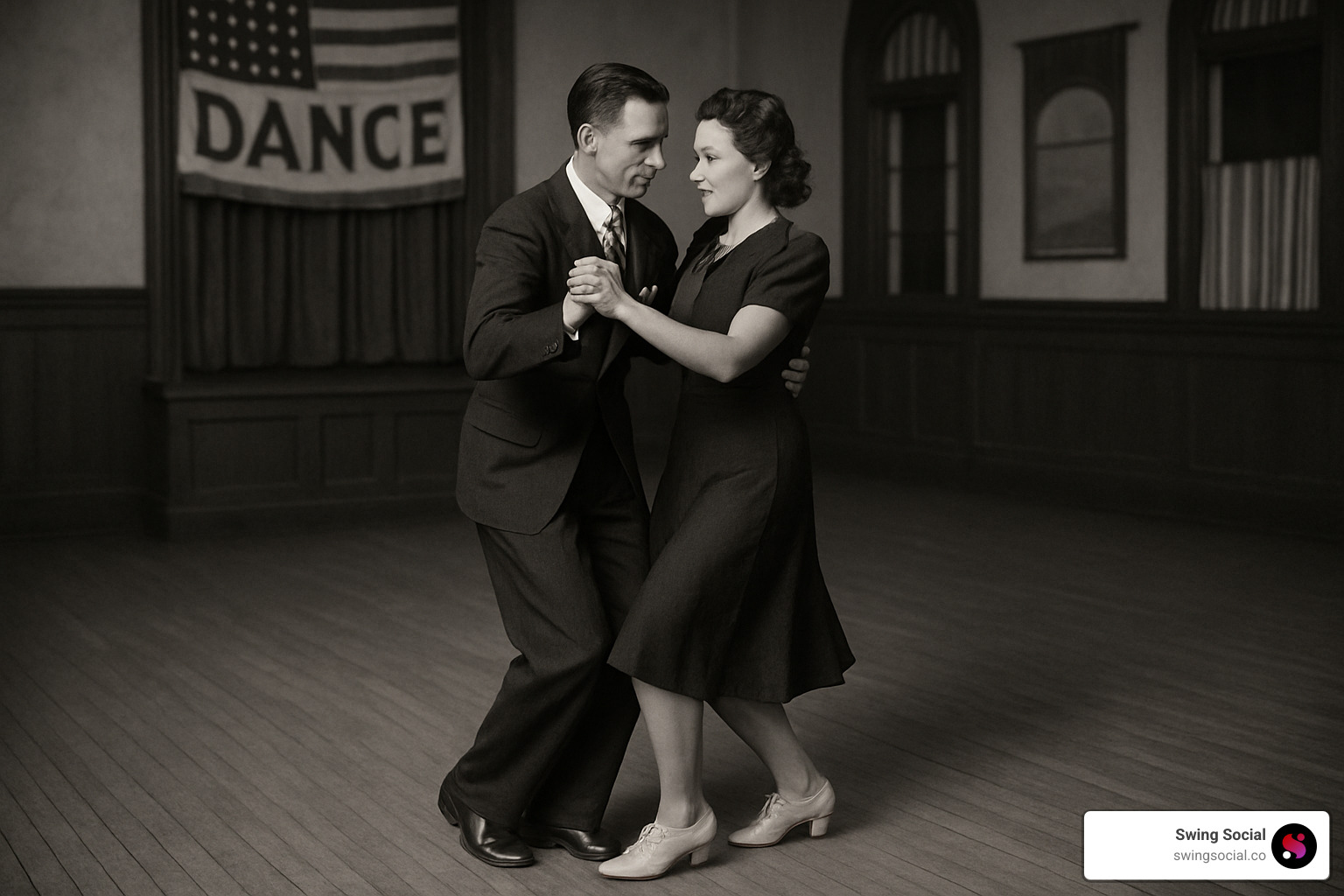
As a beginner, you’ll likely start with simple patterns like East Coast Swing’s “rock step, triple step, triple step” (counts 1-2, 3&4, 5&6). What makes swing style dancing so magical is its dual nature – it’s both instantly accessible and endlessly deep.
Looking to explore different types of swing dances in more depth? This comprehensive guide breaks down ten popular styles with their distinctive characteristics.
Modern Legacy, Influence & Getting Started
The influence of swing style extends far beyond its original era, touching virtually every aspect of American music and dance that followed.
Cross-Genre Impact
Swing style has influenced numerous musical genres:
- Western Swing: Artists like Bob Wills combined swing with country music elements
- Gypsy Jazz: Django Reinhardt and Stephane Grappelli created a European string-based approach to swing
- Jump Blues: Louis Jordan and others developed a smaller-combo approach that bridged swing and early rock and roll
- New Jack Swing: In the late 1980s, producers like Teddy Riley fused swing rhythms with hip-hop and R&B
- Electro Swing: Contemporary artists like Parov Stelar and Caravan Palace blend vintage swing samples with electronic dance music
Even modern pop music occasionally shows swing influence—Michael Bublé, Robbie Williams, and other contemporary crooners have recorded swing-influenced albums.
Fashion & Culture
The cultural impact of swing style extends to fashion:
- Swing Dresses: High-waisted, full-skirted dresses that emphasize movement on the dance floor
- Zoot Suits: The oversized, flamboyant suits popular among swing dancers in the 1940s
- Vintage Hairstyling: Victory rolls, pin curls, and other vintage hairstyles
This aesthetic has experienced multiple revivals, most recently through social media platforms where vintage fashion enthusiasts share styling tips.
How to Dive In Today
Ready to experience swing style for yourself? Here’s how to get started:
- Find Local Classes: Most cities have swing dance communities offering beginner lessons
- Attend Social Dances: Practice with different partners in a supportive environment
- Listen to the Music: Familiarize yourself with classic swing bands and modern swing revival bands
- Watch Videos: Study vintage clips from films like “Hellzapoppin'” (1941) to see original swing dancers in action
- Attend Workshops: Weekend events bring together dancers for intensive learning and social dancing
At Swing Social, we connect swing enthusiasts across our many locations from Miami to Istanbul, Cancun to Barcelona. Our platform helps you find dance partners, events, and communities wherever you travel.
Frequently Asked Questions about Swing Style
What is the easiest swing style for beginners?
If you’re just starting your dance journey, East Coast Swing is your friendly gateway into the swing style world. With its straightforward 6-count pattern (rock step, triple step, triple step) and natural circular movements, it clicks for most newcomers right away.
Many teachers start with simplified single steps before introducing the bouncy triple steps. While true mastery takes practice, you’ll be having fun on the dance floor after just one lesson.
How did African American communities shape swing style?
The heart and soul of swing style beats directly from African American innovation and creativity. The legendary Savoy Ballroom in Harlem wasn’t just a dance hall—it was a cultural laboratory where dancers like “Shorty” George Snowden, Frankie Manning, and Norma Miller created and refined what we now call Lindy Hop.
The distinctive rhythmic magic evolved directly from African musical traditions, with their rich emphasis on syncopation, call-and-response patterns, and complex rhythms. Pioneering bandleaders like Duke Ellington, Count Basie, Chick Webb, and Jimmie Lunceford developed the big band swing sound.
Today’s swing communities are actively working to recognize historical contributions and honor these original innovators.
Can swing style work with modern pop music?
You bet it can! While traditional jazz has that classic swing style sound, the fundamental dance elements adapt beautifully to today’s music with the right beat structure. West Coast Swing has especially evolved to flow seamlessly with contemporary pop, R&B, and even hip-hop tracks.
Groups like Postmodern Jukebox have built their entire brand on arranging modern hits with vintage swing style flair, creating perfect bridges between musical eras.
The secret is finding music with that undeniable rhythmic pulse that captures the essential swing feeling. As Duke Ellington famously put it: “It don’t mean a thing if it ain’t got that swing!”
Conclusion
There’s something magical about swing style that continues to captivate us decades after its heyday. It’s not just music or dance—it’s a living, breathing cultural phenomenon that transformed America and continues to bring joy worldwide.
What makes swing style endure when countless other trends have faded? I believe it’s the perfect balance of structure and freedom. The framework of rhythm and basic patterns creates a foundation, but within that structure lies infinite room for personal expression and creativity.
The accessibility of swing is another key to its enduring appeal. You don’t need years of training to enjoy your first swing dance—within an hour, most people can learn enough to have fun. Yet even after decades, dancers continue finding new nuances and expressions within the form.
Today’s swing communities honor the African American origins of the dance while welcoming participants from all backgrounds. Modern swing festivals, classes, and social dances create spaces where people connect face-to-face, a refreshing alternative to our screen-dominated social lives.
At Swing Social, we’re passionate about nurturing these connections. Whether you’re in Miami or Mykonos, Cancun or Barcelona, our platform helps you find your rhythm—and your people. We believe in the power of swing style to bring people together, creating meaningful connections through shared passion.
As Count Basie wisely said, “The real way to enjoy jazz is to get up and dance to it.” We couldn’t agree more. So put on your dancing shoes, find the beat, and join the vibrant, welcoming community of swing style enthusiasts.
Ready to connect with fellow swing enthusiasts? Visit Swing Social today and find events, classes, and dance partners in your area or wherever your travels take you. For more information about different swinger styles, we’ve got you covered.
